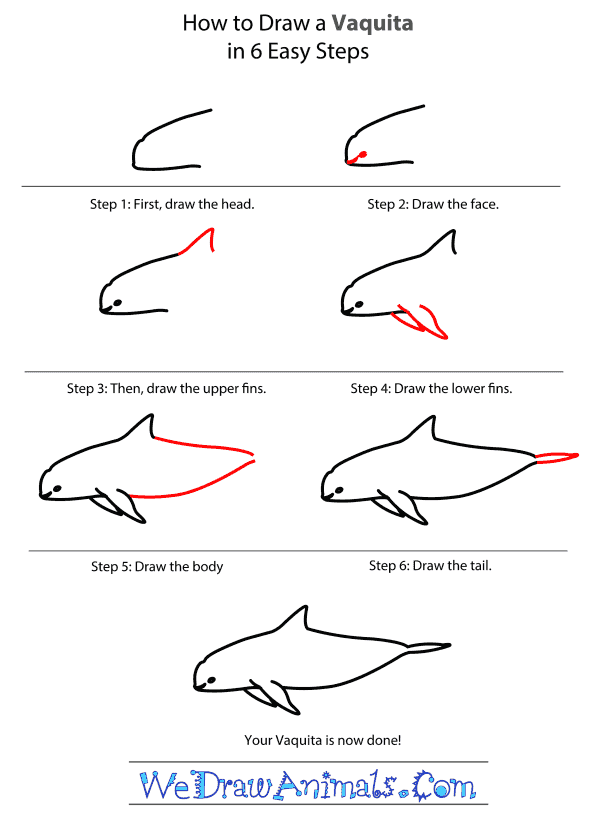In this quick tutorial you'll learn how to draw a Vaquita in 6 easy steps - great for kids and novice artists.
The images above represent how your finished drawing is going to look and the steps involved.
Below are the individual steps - you can click on each one for a High Resolution printable PDF version.
At the bottom you can read some interesting facts about the Vaquita.
Make sure you also check out any of the hundreds of drawing tutorials grouped by category.
How to Draw a Vaquita - Step-by-Step Tutorial
Step 1: First, let us start by drawing the outline of the Vaquita’s head using a curved line and a straight line below it. Draw a groove for the mouth line of the porpoise and one more at the top of the head for the blowhole.
Step 2: Draw a small oval for the eye of the Vaquita and fill it in. Draw a small curve as shown for the mouth of the Vaquita.
Step 3: On the top of the Vaquita’s body, draw the pointed upper fin using a slanting line and a small curve.
Step 4: Draw the narrow V-shaped fins on the lower part of the body using slanting lines. Make one fin smaller than the other to make the drawing more realistic.
Step 5: Draw the conical body of the Vaquita using two gently curved lines.
Step 6: Draw the thin and tube shaped tail of the Vaquita using two gently curved lines ending in a point. After you finish your drawing of the Vaquita, you can color it.
Interesting Facts about the Vaquita (Phocoena sinus):
The vaquita is a small species of porpoise that only lives in the northern part of the Gulf of California. Its name means “little cow” in Spanish. It is smaller than an average-sized human, or about 1.3 meters long. Vaquitas have stocky little bodies with a rounded head and hardly any beak, giving them a “sweet” or “cute” appearance.
Did you know?
- Vaquitas are born a very dark grey, but get lighter in color as they get older.
- Vaquitas have the most limited range of any species of whale, dolphin or porpoise.
- These animals are considered very shy and timid, making them difficult to study.
- Vaquitas are usually solitary or in small groups of two to three.
- They have dark black “rings” around their eyes, and black patches on their lips and chins.
Of all the whales, dolphins and porpoises in the world, the vaquita is the most critically endangered species. There may be as many as six hundred or as few as one hundred vaquitas left in the wild today. The biggest threat to their survival is commercial fishing, as they get caught in the big nets used by fishermen and then drown. Pollution is also a threat, as is in-breeding, since there are so few vaquitas left in the wild.







